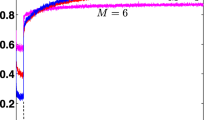Abstract
Compared with the rank reduction estimator (RARE) based on second-order statistics (called SOS-RARE), the RARE based on fourth-order cumulants (referred to as FOC-RARE) can handle more sources and restrain the negative impacts of the Gaussian colored noise. However, the unexpected modeling errors appearing in practice are known to significantly degrade the performance of the RARE. Therefore, the direction-of-arrival (DOA) estimation performance of the FOC-RARE is quantitatively derived. The explicit expression for direction-finding (DF) error is derived via the first-order perturbation analysis, and then the theoretical formula for the mean square error (MSE) is given. Simulation results demonstrate the validation of the theoretical analysis and reveal that the FOC-RARE is more robust to the unexpected modeling errors than the SOS-RARE.
Similar content being viewed by others
References
SEE C M S. Sensor array calibration in the presence of mutual coupling and unknown sensor gains and phases [J]. Electronics Letters, 1994, 30(5): 373–374.
NG B C, SEE C M S. Sensor array calibration using a maximum-likelihood approach [J]. IEEE Transactions on Antennas and Propagation, 1996, 44(6): 827–835.
CHENG Q, HUA Y B, STOICA P. Asymptotic performance of optimal gain-and-phase estimators of sensor arrays [J]. IEEE Transactions on Signal Processing, 2000, 48(12): 3587–3590.
FRIEDLANDER B, WEISS A J. Direction finding in the presence of mutual coupling [J]. IEEE Transactions on Antennas and Propagation, 1991, 39(3): 273–284.
SELLONE F, SERRA A. A novel mutual coupling compensation algorithm for uniform and linear arrays [J]. IEEE Transactions on Signal Processing, 2007, 55(2): 560–573.
WIJNHOLDS S J, VEEN A J. Multisource self-calibration for sensor arrays [J]. IEEE Transactions on Signal Processing, 2009, 57(9): 3512–3522.
YE Z F, DAI J S, XU X, WU X P. DOA estimation for uniform linear array with mutual coupling [J]. IEEE Transactions on Aerospace and Electronic Systems, 2009, 45(1): 280–288.
WANG B H, WANG Y L, CHEN H. Robust DOA estimation and array calibration in the presence of mutual coupling for uniform linear array [J]. Science in China Ser. F: Information Sciences, 2004, 47(3): 348–361.
QI C, WANG Y, ZHANG Y, CHEN H. DOA estimation and self-calibration algorithm for uniform circular array [J]. Electronics Letters, 2005, 41(20): 1092–1094.
GOOSSENS R, ROGIER H. A hybrid UCA-RARE/Root-MUSIC approach for 2-D direction of arrival estimation in uniform circular arrays in the presence of mutual coupling [J]. IEEE Transactions on Antennas and Propagation, 2007, 55(3): 841–849.
LIU C, YE Z F, ZHANG Y F. Autocalibration algorithm for mutual coupling of planar array [J]. Signal Processing, 2010, 90(3): 784–794.
WANG B H, WANG Y L, CHEN H, GUO Y. Array calibration of angularly dependent gain and phase uncertainties with carry-on instrumental sensors [J]. Science in China Ser. F: Information Sciences, 2004, 47(6): 777–792.
PESAVENTO M, GERSHMAN A B, WONG K M. Direction finding in partly calibrated sensor arrays composed of multiple subarrays [J]. IEEE Transactions on Signal Processing, 2002, 50(9): 2103–2115.
SEE C M S, GERSHMAN A B. Direction-of-arrival estimation in partly calibrated subarray-based sensor arrays [J]. IEEE Transactions on Signal Processing, 2004, 52(2): 329–338.
XIANG L, YE Z, XU X, CHANG C, XU W, HUANG Y S. Direction of arrival estimation for uniform circular array based on fourth-order cumulants in the presence of unknown mutual coupling [J]. IET Microwaves, Antennas and Propagation, 2008, 2(3): 281–287.
LI X B, SHI Y W, ZHANG H. RARE-Cumulant algorithm for direction of arrival estimation and array calibration [C]// Proceedings of International Conference on Advanced Infocomm Technology. Shengzhen: IEEE Press, 2008: 29–31.
YE Z F, DAI J S. DOA estimation for nonuniform circular array with mutual coupling based on fourth order cumulants [J]. Journal of University of Science and Technology of China, 2008, 38(7): 770–775.
LIU F, LV J Q. Signal direction of arrival estimation based high-order cumulants and a partially calibrated array [C]// Proceedings of IEEE International Conference on Communications, Circuits and Systems. Guilin: IEEE Press, 2006: 293–297.
WANG D, WU Y. Cumulants-based instrumental sensors method for self-calibration of sensor position errors [J]. Systems Engineering and Electronics, 2010, 32(7): 143–150. (in Chinese)
WU B, CHEN H, LI J D. Direction of arrival (DOA) estimation under non-Toeplitz mutual coupling matrix of ULA [J]. Radar Science and Technology, 2009, 7(5): 358–364. (in Chinese)
SHERIF A E, ALEX B G, KON M W. Rank reduction direction-of-arrival estimators with an improved robustness against subarray orientation errors [J]. IEEE Transactions on Signal Processing, 2006, 54(5): 1951–1955.
WANG D, WU Y. Performance analysis of rank reduction estimator in the presence of unexpected modeling errors [J]. Journal on Communications, 2011, 32(8): 81–90. (in Chinese)
LIAO G S, BAO Z, WANG B. Robustness analysis of 4-order cumulants-based MUSIC algorithm in presence of sensor errors [J]. Journal on Communications, 1997, 18(8): 33–38. (in Chinese)
PORAT B, FRIEDLANDER B. Direction finding algorithms based on high-order statistics [J]. IEEE Transactions on Signal Processing, 1991, 39(9): 2016–2023.
Author information
Authors and Affiliations
Corresponding author
Additional information
Foundation item: Project(61201381) supported by the National Natural Science Foundation of China; Project(YP12JJ202057) supported by the Future Development Foundation of Zhengzhou Information Science and Technology College, China
Rights and permissions
About this article
Cite this article
Wang, D. Performance of cumulant-based rank reduction estimator in presence of unexpected modeling errors. J. Cent. South Univ. 22, 992–1001 (2015). https://doi.org/10.1007/s11771-015-2610-y
Received:
Accepted:
Published:
Issue Date:
DOI: https://doi.org/10.1007/s11771-015-2610-y




